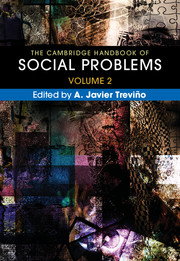Book contents
- The Cambridge Handbook of Social Problems
- The Cambridge Handbook of Social Problems
- Copyright page
- Contents
- About the Contributors
- Introduction
- Part I Problems Related to Health, Safety, and Security
- Chapter 1 Illness and Health Care
- Chapter 2 Mental Illness and Social Problems
- Chapter 3 Substance Abuse
- Chapter 4 Epidemics, Pandemics, and Outbreaks
- Chapter 5 Disaster as Social Problem and Social Construct
- Chapter 6 Surveillance
- Chapter 7 Domestic Spying: A Historical-Comparative Perspective
- Chapter 8 Computer Hacking as a Social Problem
- Chapter 9 War and Militarism
- Chapter 10 The Social Problem of Terrorism
- Chapter 11 Genocide
- Part II Problems Related to Crime and Violence
- Part III Problems of Global Impact
- Index
- References
Chapter 9 - War and Militarism
from Part I - Problems Related to Health, Safety, and Security
Published online by Cambridge University Press: 16 March 2018
- The Cambridge Handbook of Social Problems
- The Cambridge Handbook of Social Problems
- Copyright page
- Contents
- About the Contributors
- Introduction
- Part I Problems Related to Health, Safety, and Security
- Chapter 1 Illness and Health Care
- Chapter 2 Mental Illness and Social Problems
- Chapter 3 Substance Abuse
- Chapter 4 Epidemics, Pandemics, and Outbreaks
- Chapter 5 Disaster as Social Problem and Social Construct
- Chapter 6 Surveillance
- Chapter 7 Domestic Spying: A Historical-Comparative Perspective
- Chapter 8 Computer Hacking as a Social Problem
- Chapter 9 War and Militarism
- Chapter 10 The Social Problem of Terrorism
- Chapter 11 Genocide
- Part II Problems Related to Crime and Violence
- Part III Problems of Global Impact
- Index
- References
Summary
Critics have treated as “social problems” both war itself and militarism, the values and structures that organization for war leaves behind after the end of actual conflict. Yet while war and militarism are both capable of causing immense suffering and social disruption, approaching them as social problems in themselves is controversial among social scientists. This entry first describes the best-known social theory concerning the causes and motivations for war. In a second section, it offers a sampling of recent scholarship documenting the effects of war on members of warring societies and on large-scale social structures. The third section reviews the historical sources of the concepts and structures associated with the term “militarism” at the time it emerged in social science literature. The final section discusses a number of phenomena that may all be called forms of “militarism,” some clearly pro-social and others clearly destructive to social order and cohesion.
- Type
- Chapter
- Information
- The Cambridge Handbook of Social Problems , pp. 143 - 154Publisher: Cambridge University PressPrint publication year: 2018
References
- 2
- Cited by



